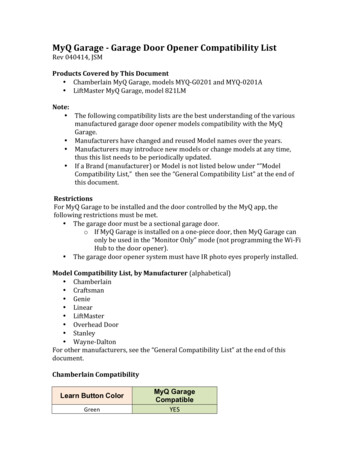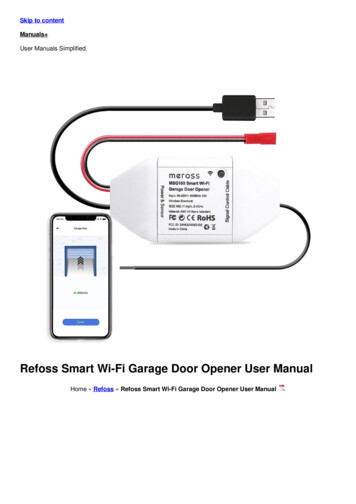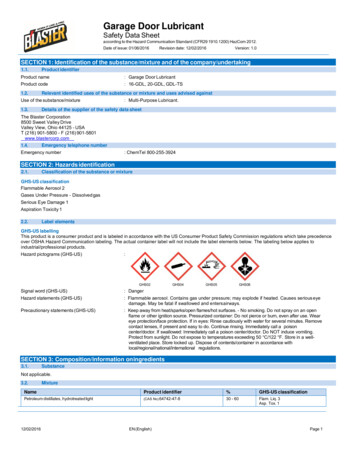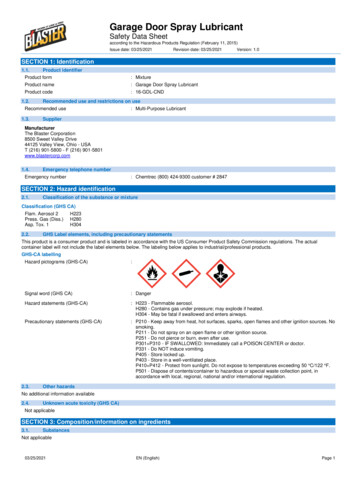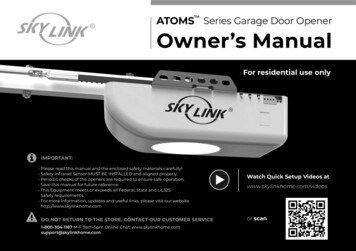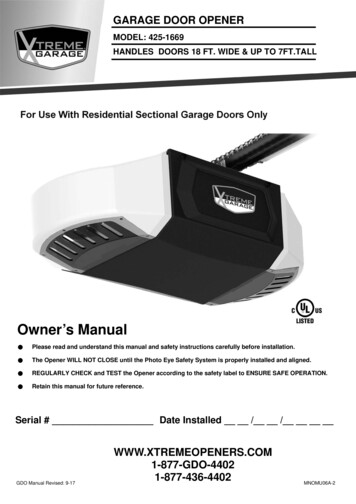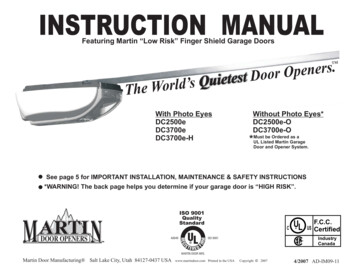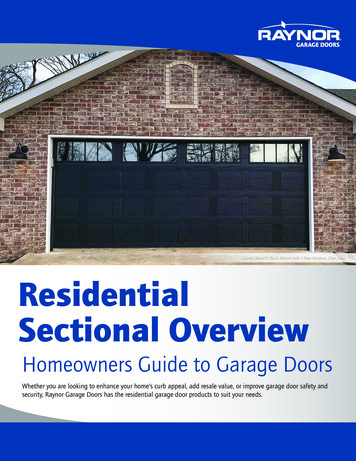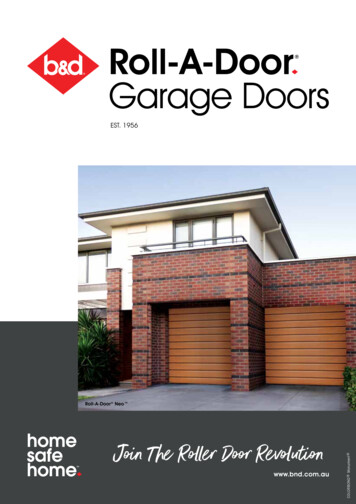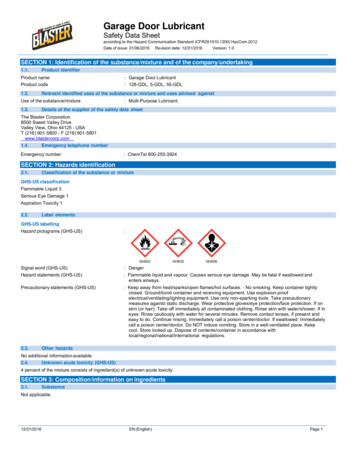
Transcription
Garage Door LubricantSafety Data Sheetaccording to the Hazard Communication Standard (CFR29 1910.1200) HazCom 2012.Date of issue: 01/06/2016Revision date: 12/01/2016Version: 1.0SECTION 1: Identification of the substance/mixture and of the company/undertaking1.1.Product identifierProduct nameProduct code1.2.Relevant identified uses of the substance or mixture and uses advised againstUse of the substance/mixture1.3.: Garage Door Lubricant: 128-GDL, 5-GDL, 55-GDL: Multi-Purpose Lubricant.Details of the supplier of the safety data sheetThe Blaster Corporation8500 Sweet Valley DriveValley View, Ohio 44125 - USAT (216) 901-5800 - F (216) 901-5801www.blastercorp.com1.4.Emergency telephone numberEmergency number: ChemTel 800-255-3924SECTION 2: Hazards identification2.1.Classification of the substance or mixtureGHS-US classificationFlammable Liquid 3Serious Eye Damage 1Aspiration Toxicity 12.2.Label elementsGHS-US labellingHazard pictograms (GHS-US):Signal word (GHS-US): DangerHazard statements (GHS-US): Flammable liquid and vapour. Causes serious eye damage. May be fatal if swallowed andenters airways.Precautionary statements (GHS-US): Keep away from heat/sparks/open flames/hot surfaces. - No smoking. Keep container tightlyclosed. Ground/bond container and receiving equipment. Use explosion-proofelectrical/ventilating/lighting equipment. Use only non-sparking tools. Take precautionarymeasures against static discharge. Wear protective gloves/eye protection/face protection. If onskin (or hair): Take off immediately all contaminated clothing. Rinse skin with water/shower. If ineyes: Rinse cautiously with water for several minutes. Remove contact lenses, if present andeasy to do. Continue rinsing. Immediately call a poison center/doctor. If swallowed: Immediatelycall a poison center/doctor. Do NOT induce vomiting. Store in a well-ventilated place. Keepcool. Store locked up. Dispose of contents/container in accordance withlocal/regional/national/international regulations.GHS022.3.GHS05GHS08Other hazardsNo additional information available.2.4.Unknown acute toxicity (GHS-US)4 percent of the mixture consists of ingredient(s) of unknown acute toxicity.SECTION 3: Composition/information on ingredients3.1.SubstanceNot applicable.12/01/2016EN (English)Page 1
Garage Door LubricantSafety Data Sheetaccording to the Hazard Communication Standard (CFR29 1910.1200) HazCom 2012.3.2.MixtureNameProduct identifier%GHS-US classificationPetroleum distillates, hydrotreated light(CAS No) 64742-47-830 - 60Naphtha, petroleum, heavy alkylate(CAS No) 64741-65-715 - 40Phosphorodithioic acid, O,O-di-C1-14-alkyl esters, zinc salts(CAS No) 68649-42-31-5Flam. Liq. 3Asp. Tox. 1Flam. Liq. 3Asp. Tox. 1Skin Irrit. 2Eye Dam. 1* The exact percentage (concentration) of composition has been withheld as a trade secret in accordance with paragraph (i) of §1910.1200.SECTION 4: First aid measures4.1.Description of first aid measuresFirst-aid measures after inhalation: If breathing is difficult, remove victim to fresh air and keep at rest in a position comfortable forbreathing. Get medical advice/attention if you feel unwell.First-aid measures after skin contact: In case of contact, immediately flush skin with plenty of water. Call a physician if irritationdevelops and persists.First-aid measures after eye contact: In case of contact, immediately flush eyes with plenty of water for at least 15 minutes. If easy todo, remove contact lenses, if worn. Immediately call a POISON CENTER or doctor/physician.First-aid measures after ingestion: Do NOT induce vomiting. Never give anything by mouth to an unconscious person.Immediately call a POISON CENTER or doctor/physician.4.2.Most important symptoms and effects, both acute and delayedSymptoms/injuries after inhalation: May cause respiratory tract irritation.Symptoms/injuries after skin contact: May cause skin irritation. Symptoms may include redness, drying, defatting and cracking of the skin.Symptoms/injuries after eye contact: Causes serious eye damage. Symptoms may include discomfort or pain, excess blinking andtear production, with marked redness and swelling of the conjunctiva. May cause burns.Symptoms/injuries after ingestion: May be fatal if swallowed and enters airways. This product may be aspirated into the lungs andcause chemical pneumonitis. May cause stomach distress, nausea or vomiting.4.3.Indication of any immediate medical attention and special treatment neededSymptoms may not appear immediately. In case of accident or if you feel unwell, seek medical advice immediately (show the label or SDS where possible).SECTION 5: Firefighting measures5.1.Extinguishing mediaSuitable extinguishing media: Dry chemical, carbon dioxide, halons, foam.Unsuitable extinguishing media: Do not use a heavy water stream.5.2.Special hazards arising from the substance or mixtureFire hazard: Products of combustion may include, and are not limited to: oxides of carbon, hydrocarbons.Explosion hazard: May form flammable/explosive vapour-air mixture.5.3.Advice for firefightersProtection during firefighting: Keep upwind of fire. Wear full fire fighting turn-out gear (full Bunker gear) and respiratoryprotection (SCBA). Use water spray to keep fire-exposed containers cool.SECTION 6: Accidental release measures6.1.Personal precautions, protective equipment and emergency proceduresGeneral measures6.2.: Use personal protection recommended in Section 8. Isolate the hazard area and deny entry tounnecessary and unprotected personnel. Eliminate sources of ignition.Methods and material for containment and cleaning upFor containment: Contain and/or absorb spill with inert material (e.g. sand, vermiculite), then place in a suitablecontainer. Do not flush to sewer or allow to enter waterways. Use appropriate PersonalProtective Equipment (PPE).Methods for cleaning up: Scoop up material and place in a disposal container. Vapors may be heavier than air and maytravel along the ground to a distant ignition source and flash back. Provide ventilation.6.3.Reference to other sectionsSee section 8 for further information on protective clothing and equipment and section 13 for advice on waste disposal.12/01/2016EN (English)2/6
Garage Door LubricantSafety Data Sheetaccording to the Hazard Communication Standard (CFR29 1910.1200) HazCom 2012.SECTION 7: Handling and storage7.1.Precautions for safe handlingPrecautions for safe handling7.2.: Keep away from sources of ignition - No smoking. Avoid breathing dust/fume/gas/mist/vapors/spray. Avoid contact with skin and eyes. Do not swallow. Handle and open container with care.Use only non-sparking tools. When using do not eat, drink or smoke. Take precautionarymeasures against static discharge. Use only outdoors or in a well-ventilated area.Conditions for safe storage, including any incompatibilitiesTechnical measures: Proper grounding procedures to avoid static electricity should be followed.Storage conditions: Keep out of the reach of children. Keep container tightly closed and in a well-ventilated place.Store locked up. Keep cool. Keep away from heat, flames and sparks.7.3.Specific end use(s)Not available.SECTION 8: Exposure controls/personal protection8.1.Control parametersPetroleum distillates, hydrotreated light (64742-47-8)USA ACGIHACGIH TWANot available.USA OSHAOSHA PEL (TWA)Not available.Naphtha, petroleum, heavy alkylate (64741-65-7)USA ACGIHACGIH TWA100 ppmUSA OSHAOSHA PEL (TWA)100 ppmPhosphorodithioic acid, O,O-di-C1-14-alkyl esters, zinc salts (68649-42-3)USA ACGIHACGIH TWANot available.USA OSHANot available.8.2.OSHA PEL (TWA)Exposure controlsAppropriate engineering controls: Use ventilation adequate to keep exposures (airborne levels of dust, fume, vapor, etc.) belowrecommended exposure limits.Hand protection: Wear chemically resistant protective gloves.Eye protection: Wear approved eye protection (properly fitted dust- or splash-proof chemical safety goggles)and face protection (face shield).Skin and body protection: Wear suitable protective clothing.Respiratory protection: In case of insufficient ventilation, wear suitable respiratory equipment. Respirator selectionmust be based on known or anticipated exposure levels, the hazards of the product and thesafe working limits of the selected respirator.Environmental exposure controls: Maintain levels below Community environmental protection thresholds.Other information: Do not eat, smoke or drink where material is handled, processed or stored. Wash handscarefully before eating or smoking. Handle according to established industrial hygiene andsafety practices.SECTION 9: Physical and chemical properties9.1.Information on basic physical and chemical propertiesPhysical state: Liquid.Appearance: Clear.Colour: Colorless.Odour: Mild aliphatic.Odour threshold: No data available.pH: No data available.Relative evaporation rate (butylacetate 1): 1Melting point: No data available.Freezing point: No data available.Boiling point: 182 C (360 F)Flash point: 54 C (130 F) [TCC]Auto-ignition temperature: No data available.12/01/2016EN (English)3/6
Garage Door LubricantSafety Data Sheetaccording to the Hazard Communication Standard (CFR29 1910.1200) HazCom 2012.Decomposition temperature: No data available.Flammability (solid, gas): Flammable.Vapour pressure: No data available.Relative vapour density at 20 C: 3.8 (Air 1)Relative density: 0.81Solubility: Negligible.Log Pow: No data available.Log Kow: No data available.Viscosity, kinematic: No data available.Viscosity, dynamic: No data available.Explosive properties: No data available.Oxidising properties: No data available.Explosive limits: No data available.9.2.Other informationNo additional information available.SECTION 10: Stability and reactivity10.1.ReactivityNo dangerous reaction known under conditions of normal use.10.2.Chemical stabilityStable under normal storage conditions. May form flammable/explosive vapour-air mixture.10.3.Possibility of hazardous reactionsNo dangerous reaction known under conditions of normal use.10.4.Conditions to avoidHeat. Incompatible materials. Sources of ignition. Excessive water.10.5.Incompatible materialsStrong oxidizing agents, strong reducing agents.10.6.Hazardous decomposition productsMay include, and are not limited to: oxides of carbon, hydrocarbons.SECTION 11: Toxicological information11.1.Information on toxicological effectsAcute toxicity: Not classified.Garage Door LubeLD50 oral ratLD50 dermal rabbitLC50 inhalation rat 2000 mg/kg 2000 mg/kgNo data available.Petroleum distillates, hydrotreated light (64742-47-8)LD50 oral rat 5000 mg/kgLD50 dermal rabbit 2000 mg/kgLC50 inhalation rat 5.2 mg/l/4hNaphtha, petroleum, heavy alkylate (64741-65-7)LD50 oral rat 7000 mg/kgLD50 dermal rabbit 2000 mg/kgLC50 inhalation rat 5.04 mg/l/4hSkin corrosion/irritation: Based on available data, the classification criteria are not met.Serious eye damage/irritation: Causes serious eye damage.Respiratory or skin sensitisation: Based on available data, the classification criteria are not met.Germ cell mutagenicity: Based on available data, the classification criteria are not met.Carcinogenicity: Based on available data, the classification criteria are not met.Reproductive toxicity: Based on available data, the classification criteria are not met.12/01/2016EN (English)4/6
Garage Door LubricantSafety Data Sheetaccording to the Hazard Communication Standard (CFR29 1910.1200) HazCom 2012.Specific target organ toxicity (single exposure) : Based on available data, the classification criteria are not met.Specific target organ toxicity (repeated exposure) : Based on available data, the classification criteria are not met.Aspiration hazard: May be fatal if swallowed and enters airways.Symptoms/injuries after inhalation: May cause respiratory tract irritation.Symptoms/injuries after skin contact: May cause skin irritation. Symptoms may include redness, drying, defatting and cracking of the skin.Symptoms/injuries after eye contact: Causes serious eye damage. Symptoms may include discomfort or pain, excess blinking andtear production, with marked redness and swelling of the conjunctiva. May cause burns.Symptoms/injuries after ingestion: May be fatal if swallowed and enters airways. This product may be aspirated into the lungs andcause chemical pneumonitis. May cause stomach distress, nausea or vomiting.SECTION 12: Ecological information12.1.ToxicityEcology - general12.2.: May cause long-term adverse effects in the aquatic environment.Persistence and degradabilityGarage Door LubePersistence and degradability12.3.Not established.Bioaccumulative potentialGarage Door LubeBioaccumulative potential12.4.Not established.Mobility in soilNo additional information available.12.5.Other adverse effectsEffect on ozone layer: No additional information available.Effect on the global warming: No known ecological damage caused by this product.SECTION 13: Disposal considerations13.1.Waste treatment methodsWaste disposal recommendations: This material must be disposed of in accordance with all local, state, provincial, and federalregulations. The generation of waste should be avoided or minimized wherever possible.Additional information: Handle empty containers with care because residual vapours are flammable.SECTION 14: Transport informationIn accordance with DOT14.1.UN numberUN-No.(DOT)14.2.UN1268UN proper shipping nameProper Shipping Name (DOT): Petroleum distillates, n.o.s. limited quantitiesDepartment of Transportation (DOT) HazardClasses: 3Hazard labels (DOT):Packing group (DOT): III14.3.Additional informationOther information: No supplementary information available.Special transport precautions: Do not handle until all safety precautions have been read and understood.SECTION 15: Regulatory information15.1. US Federal regulationsAll components of this product are listed, or excluded from listing, on the United States Environmental Protection Agency ToxicSubstances Control Act (TSCA) inventory.12/01/2016EN (English)5/6
Garage Door LubricantSafety Data Sheetaccording to the Hazard Communication Standard (CFR29 1910.1200) HazCom 2012.15.2. US State regulationsGarage Door LubeState or local regulationsThis product does not contain a chemical known to the State of California to cause cancer,birth defects or other reproductive harm.SECTION 16: Other informationDate of issue: 01/06/2016Revision date: 12/01/2016Other information: None.Disclaimer: We believe the statements, technical information and recommendations contained herein are reliable, but they are given without warranty or guarantee of any kind. The information containedin this document applies to this specific material as supplied. It may not be valid for this material if it is used in combination with any other materials. It is the user’s responsibility to satisfy oneself as to thesuitability and completeness of this information for the user’s own particular use.01/06/2016EN (English)6/6
Garage Door Lubricant Safety Data Sheet according to the Hazard Communication Standard (CFR291910.1200) HazCom 2012. Date of issue: 01/06/2016 Revisiondate: 12/01/2016 Version: 1.0 . SECTION 1: Identification of the substance/mixture and of the company/undertaking . Product name : Garage Door Lubricant Product code : 128-GDL, 5-GDL, 55-GDL
